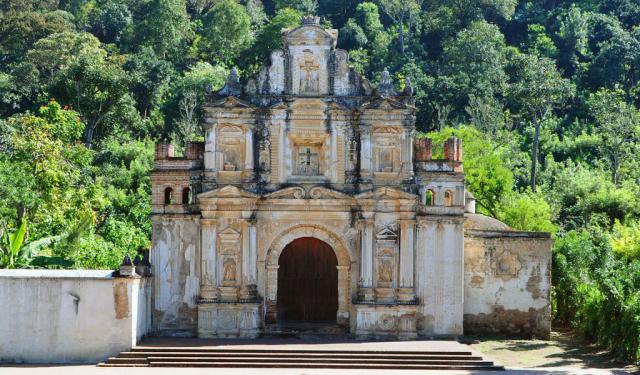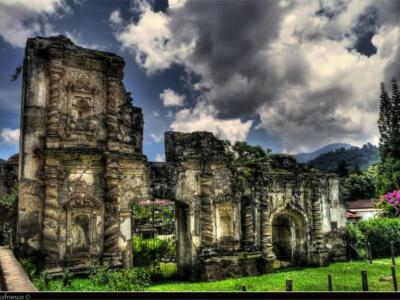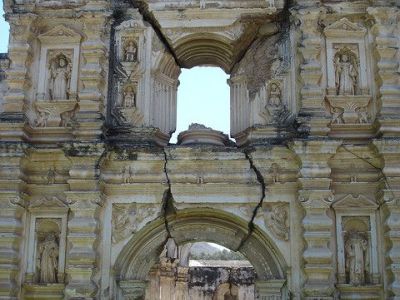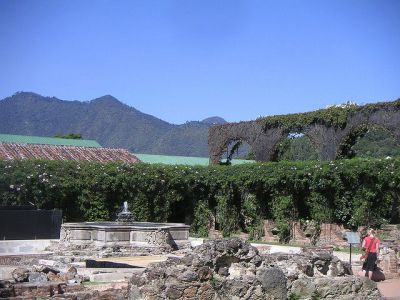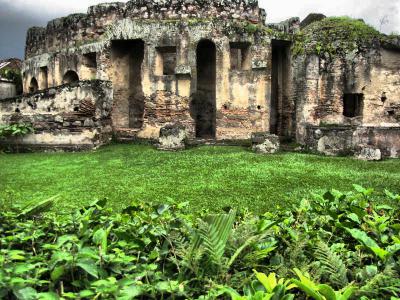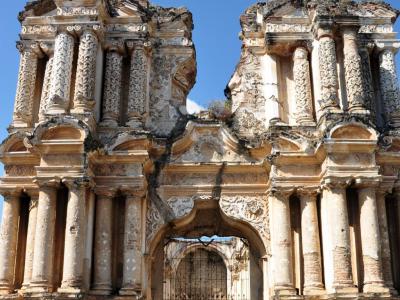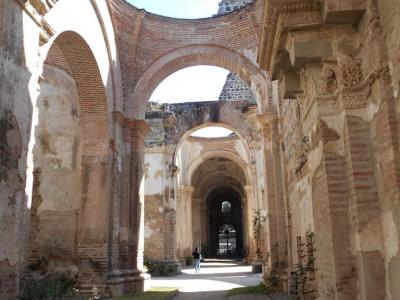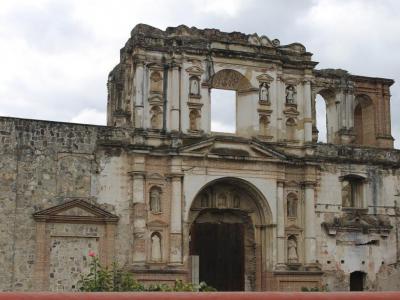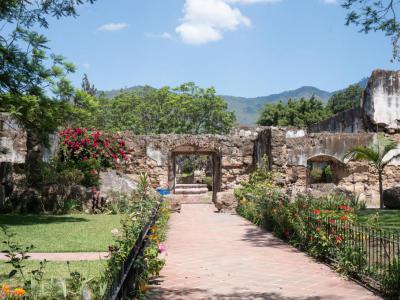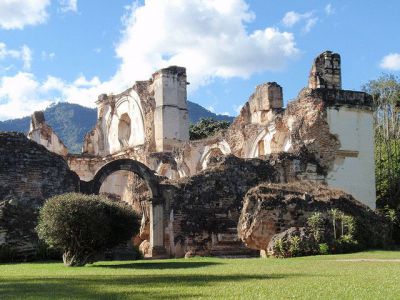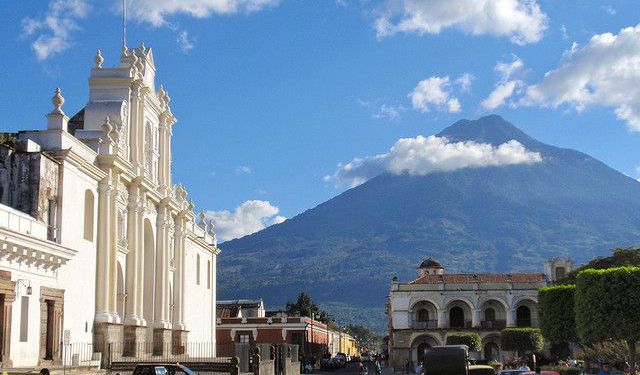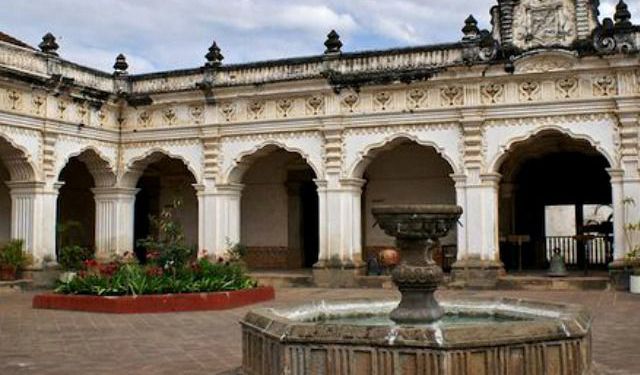Ancient Ruins of Antigua (Self Guided), Antigua
In places like Antigua Guatemala, it feels as if a time machine has already been invented. This glorious ancient town breathes history in all its streets, houses, fountains, and courtyards, but above all the great ruins, which are impossible to miss against the impressive backdrop of Agua Volcano. The latter is responsible for these ruins in the first place, having caused a series of earthquakes throughout centuries.
Among the prominent such ruins is the Church of Candelaria, a once charming colonial-era temple known for its Baroque-style architecture.
Our next stop is the Church of Santa Rosa. This church, or rather what's left of it now, offers a hauntingly beautiful view of its former glory, with its crumbling walls and faded frescoes.
The Church of Santo Domingo is another noteworthy site. Its ruins evoke a sense of history and mystery with the almost razed-to-the-ground remnants.
To those with vivid imagination, the historic Convent of the Capuchins can offer insight into the monastic life during the colonial era.
The adjacent El Carmen Church's ruins feature weathered stone facades and fragments of religious art, serving as a testament to the craftsmanship of its period.
The Santa Clara Convent and Church, on the other hand, exude a sense of tranquility, with its peaceful courtyards and serene atmosphere, while simultaneously showcasing the architectural prowess of the times long gone.
The San Jose Cathedral's ruins offer a dramatic view of what was once a magnificent place of worship, with its towering arches and fallen columns.
The Church and School of the Society of Jesus: Its ruins are a reminder of the Jesuit presence in Antigua, with remnants of their educational and religious institutions.
Meanwhile, the San Jeronimo Convent's ruins reflect the austere life of the friars, with simple yet profound architecture.
Finally, the ruins of La Recolección showcase the elegance of colonial architecture and the grandeur of Antigua's ecclesiastical structures.
Visiting these ancient ruins allows you to step back in time and appreciate the artistry and history of Guatemala. Embark on this self-guided tour of Antigua and immerse yourself in the rich cultural tapestry the city has to offer. Your visit not only preserves this cultural heritage but also supports the local community and economy.
Among the prominent such ruins is the Church of Candelaria, a once charming colonial-era temple known for its Baroque-style architecture.
Our next stop is the Church of Santa Rosa. This church, or rather what's left of it now, offers a hauntingly beautiful view of its former glory, with its crumbling walls and faded frescoes.
The Church of Santo Domingo is another noteworthy site. Its ruins evoke a sense of history and mystery with the almost razed-to-the-ground remnants.
To those with vivid imagination, the historic Convent of the Capuchins can offer insight into the monastic life during the colonial era.
The adjacent El Carmen Church's ruins feature weathered stone facades and fragments of religious art, serving as a testament to the craftsmanship of its period.
The Santa Clara Convent and Church, on the other hand, exude a sense of tranquility, with its peaceful courtyards and serene atmosphere, while simultaneously showcasing the architectural prowess of the times long gone.
The San Jose Cathedral's ruins offer a dramatic view of what was once a magnificent place of worship, with its towering arches and fallen columns.
The Church and School of the Society of Jesus: Its ruins are a reminder of the Jesuit presence in Antigua, with remnants of their educational and religious institutions.
Meanwhile, the San Jeronimo Convent's ruins reflect the austere life of the friars, with simple yet profound architecture.
Finally, the ruins of La Recolección showcase the elegance of colonial architecture and the grandeur of Antigua's ecclesiastical structures.
Visiting these ancient ruins allows you to step back in time and appreciate the artistry and history of Guatemala. Embark on this self-guided tour of Antigua and immerse yourself in the rich cultural tapestry the city has to offer. Your visit not only preserves this cultural heritage but also supports the local community and economy.
How it works: Download the app "GPSmyCity: Walks in 1K+ Cities" from Apple App Store or Google Play Store to your mobile phone or tablet. The app turns your mobile device into a personal tour guide and its built-in GPS navigation functions guide you from one tour stop to next. The app works offline, so no data plan is needed when traveling abroad.
Ancient Ruins of Antigua Map
Guide Name: Ancient Ruins of Antigua
Guide Location: Guatemala » Antigua (See other walking tours in Antigua)
Guide Type: Self-guided Walking Tour (Sightseeing)
# of Attractions: 10
Tour Duration: 2 Hour(s)
Travel Distance: 3.5 Km or 2.2 Miles
Author: Nick
Sight(s) Featured in This Guide:
Guide Location: Guatemala » Antigua (See other walking tours in Antigua)
Guide Type: Self-guided Walking Tour (Sightseeing)
# of Attractions: 10
Tour Duration: 2 Hour(s)
Travel Distance: 3.5 Km or 2.2 Miles
Author: Nick
Sight(s) Featured in This Guide:
- Church of Candelaria (ruins)
- Church of Santa Rosa (ruins)
- Church of Santo Domingo (ruins)
- Convent of the Capuchins
- El Carmen Church (ruins)
- Santa Clara Convent and Church
- San Jose Cathedral (ruins)
- Church and School of the Society of Jesus (ruins)
- San Jeronimo Convent (ruins)
- La Recoleccion (ruins)
1) Church of Candelaria (ruins)
The Church of Candelaria, located in Antigua, offers a compelling glimpse into the rich history and architectural heritage of this former capital city. Antigua, set within the central highlands of Guatemala, was the country's hub for two centuries until it was largely devastated by a major earthquake in 1773. Today, the city is a UNESCO World Heritage site, celebrated for its beautifully restored colonial architecture, including numerous churches and monasteries, and its quaint cobblestone streets.
The Church of Candelaria was originally constructed between 1548 and 1550 as a parish church dedicated to serving the indigenous population under the auspices of Bishop Francisco Marroquín. It epitomizes the Baroque architectural style, characterized by ornate swirling columns and meticulous filigree detailing. This style is further accentuated by a façade featuring stucco floral designs and Mudejar-inspired ornamental elements, added during a rebuilding phase between 1718 and 1722 following the earthquake of 1717.
Despite efforts to rebuild and restore, the church suffered significant damage during subsequent earthquakes, particularly the devastating one in 1773, which reduced much of it to ruins. The remains of the church, with their dramatic rubble and partial structures, now stand as a poignant reminder of Antigua's turbulent past. Efforts are ongoing to stabilize and possibly restore these ruins, enhancing their appeal as a major tourist destination within the city. These efforts not only aim to preserve a piece of architectural history but also to contribute to the continued attraction of tourists to this historic city.
The Church of Candelaria was originally constructed between 1548 and 1550 as a parish church dedicated to serving the indigenous population under the auspices of Bishop Francisco Marroquín. It epitomizes the Baroque architectural style, characterized by ornate swirling columns and meticulous filigree detailing. This style is further accentuated by a façade featuring stucco floral designs and Mudejar-inspired ornamental elements, added during a rebuilding phase between 1718 and 1722 following the earthquake of 1717.
Despite efforts to rebuild and restore, the church suffered significant damage during subsequent earthquakes, particularly the devastating one in 1773, which reduced much of it to ruins. The remains of the church, with their dramatic rubble and partial structures, now stand as a poignant reminder of Antigua's turbulent past. Efforts are ongoing to stabilize and possibly restore these ruins, enhancing their appeal as a major tourist destination within the city. These efforts not only aim to preserve a piece of architectural history but also to contribute to the continued attraction of tourists to this historic city.
2) Church of Santa Rosa (ruins)
The Church of Santa Rosa, nestled in the historic heart of Antigua Guatemala, stands as a profound emblem of resilience amidst the captivating ruins that characterize this colonial city. Constructed in 1570 as a convent, the complex was specifically built for a sisterhood recognizable by their white clothing. Over the centuries, it transitioned into a church, withstanding the test of time and natural disasters, particularly the severe earthquakes of the 18th century.
These earthquakes left indelible marks on the church, notably two prominent cracks that slice through the main structure. These fissures narrate the violent shakes that once ravaged the region, yet they also underscore the building's enduring strength. Despite the collapse of its domes long ago, the church maintains its grandeur, proudly displaying an architectural style that speaks volumes about the colonial era's aesthetic and structural ambitions.
Visitors to the Church of Santa Rosa are greeted by its striking façade, which remains intricately adorned despite the seismic damage. The façade prominently features Santa Rosa de Lima, the patron saint depicted with a crown of roses and holding the infant Jesus. Accompanying her are sculptures of Dominican saints such as Santo Domingo, San Francisco, and San Vicente Ferrer, each contributing to the religious and artistic richness of the edifice.
The Church of Santa Rosa is more than a mere historical site; it is a testament to the ingenuity and craftsmanship of its builders and the enduring spirit of the people of Antigua Guatemala. As one of the prime colonial ruins in the city, it offers visitors a profound glimpse into the past, while celebrating the cultural and architectural heritage that continues to thrive in the face of adversity.
These earthquakes left indelible marks on the church, notably two prominent cracks that slice through the main structure. These fissures narrate the violent shakes that once ravaged the region, yet they also underscore the building's enduring strength. Despite the collapse of its domes long ago, the church maintains its grandeur, proudly displaying an architectural style that speaks volumes about the colonial era's aesthetic and structural ambitions.
Visitors to the Church of Santa Rosa are greeted by its striking façade, which remains intricately adorned despite the seismic damage. The façade prominently features Santa Rosa de Lima, the patron saint depicted with a crown of roses and holding the infant Jesus. Accompanying her are sculptures of Dominican saints such as Santo Domingo, San Francisco, and San Vicente Ferrer, each contributing to the religious and artistic richness of the edifice.
The Church of Santa Rosa is more than a mere historical site; it is a testament to the ingenuity and craftsmanship of its builders and the enduring spirit of the people of Antigua Guatemala. As one of the prime colonial ruins in the city, it offers visitors a profound glimpse into the past, while celebrating the cultural and architectural heritage that continues to thrive in the face of adversity.
3) Church of Santo Domingo (ruins)
The Church of Santo Domingo in Antigua stands as a testament to the grandeur and historical significance of the once-flourishing 16th-century convent of the Santo Domingo Order. Established in 1542, this convent quickly became the largest and wealthiest in Antigua, reflecting the prominence of the Santo Domingo Order during that era. Tragically, a series of earthquakes in the 18th century devastated the structure, leaving only ruins behind which were not uncovered until excavations in the 1970s. These ruins were later incorporated into a hotel that opened in the 1990s, providing a unique blend of historical preservation and modern hospitality.
Visitors to the site can explore various aspects of the former convent's daily life through the preserved domestic areas, kitchens, chapels, stairways, and fountains. One of the more poignant exhibits includes skeletons displayed behind glass, offering a somber reflection on the lives of those who once inhabited the convent. Additionally, the site hosts multiple museums that enrich the visitor's experience with displays of colonial and pre-Columbian art, archaeological finds, and intricate silverwork. These exhibits not only highlight the cultural richness of the region but also its historical layers.
The Church of Santo Domingo is an essential destination for those interested in the cultural heritage and history of Guatemala. It provides a compelling glimpse into the past life of a significant religious and social institution in Antigua, enhanced by educational exhibits and the atmospheric presence of the ruins themselves. This site encourages visitors to immerse themselves in history, offering a profound understanding of the area's past and its enduring legacy.
Visitors to the site can explore various aspects of the former convent's daily life through the preserved domestic areas, kitchens, chapels, stairways, and fountains. One of the more poignant exhibits includes skeletons displayed behind glass, offering a somber reflection on the lives of those who once inhabited the convent. Additionally, the site hosts multiple museums that enrich the visitor's experience with displays of colonial and pre-Columbian art, archaeological finds, and intricate silverwork. These exhibits not only highlight the cultural richness of the region but also its historical layers.
The Church of Santo Domingo is an essential destination for those interested in the cultural heritage and history of Guatemala. It provides a compelling glimpse into the past life of a significant religious and social institution in Antigua, enhanced by educational exhibits and the atmospheric presence of the ruins themselves. This site encourages visitors to immerse themselves in history, offering a profound understanding of the area's past and its enduring legacy.
4) Convent of the Capuchins (must see)
One of the finest examples of an 18th-century convent in Guatemala, the Convent of the Capuchins was consecrated in 1736. In fact, it was the last convent to be built in the city, and the first one that stopped asking for a donation to the new nuns, allowing then poor ladies to embrace religious life. Daily routine for the nuns was ruled by strict regulations, which included, for some, maximum discipline on poverty, penance and fasting. Drinking chocolate was strictly forbidden and the requirement that they should survive on the tithing only.
Like the rest of the city, the building complex suffered damage during the 1751 and 1773 earthquakes, and was abandoned by order of the Captain-General at the time. Today, the monastery's well-preserved cells, gardens, and courtyards are open for public viewing and provide excellent photo-ops. Each twist and turn presents a view your camera will ache to capture! It's also interesting to see how small the cloisters were, and how the nuns lived during colonial times.
Tip:
The only guide is the map in the first room, so study it carefully! Don't miss the round room beneath the Nun's tower: sing quietly and be rewarded – the acoustics are incredible. The 2nd-floor art display is new and very nice, as well.
Like the rest of the city, the building complex suffered damage during the 1751 and 1773 earthquakes, and was abandoned by order of the Captain-General at the time. Today, the monastery's well-preserved cells, gardens, and courtyards are open for public viewing and provide excellent photo-ops. Each twist and turn presents a view your camera will ache to capture! It's also interesting to see how small the cloisters were, and how the nuns lived during colonial times.
Tip:
The only guide is the map in the first room, so study it carefully! Don't miss the round room beneath the Nun's tower: sing quietly and be rewarded – the acoustics are incredible. The 2nd-floor art display is new and very nice, as well.
5) El Carmen Church (ruins)
El Carmen Church (La Iglesia de Nuestra Señora del Carmen) stands as a historic relic in Antigua, embodying centuries of cultural and architectural heritage. Initially granted construction permission in 1638 by the city council of Santiago de los Caballeros, the church was intended to serve the Carmelite nuns displaced by the catastrophic earthquakes of 1773.
The original structure of El Carmen Church was significantly damaged by an earthquake in 1651. Subsequently, a more robust church was constructed in 1686, only to be destroyed again by another earthquake in 1717. A third iteration, completed in 1728, was renowned for its elaborate design and cultural significance, hosting prestigious events and becoming a key religious site in the region.
However, the resilience of El Carmen Church was continuously tested by seismic activity. The church suffered extensive damage during the earthquakes of 1773, which destroyed the dome, vaults, and bell tower, and later in 1976, which damaged the effigy of Our Lady of Carmen. Despite ongoing efforts to stabilize the ruins, much of the church remains in disrepair.
Today, El Carmen Church is inactive, no longer hosting regular religious services, but its facade, adorned with ornate stonework and majestic columns, still stands as a testament to the Guatemalan seismic Baroque style. The facade has weathered multiple earthquakes and retains its architectural splendor, making it a prominent feature in the cityscape of Santiago de los Caballeros de Guatemala.
Visitors to Antigua cannot enter the church but can admire its exterior and intricate details from the street, peering through protective bars. Adjacent to the church is a vibrant handicrafts market, offering a range of local artisanal products. This market provides an excellent opportunity for visitors to engage with the local culture and shop for unique gifts, though bargaining may be necessary to secure the best prices.
El Carmen Church, with its rich history and stunning facade, remains a must-visit landmark in Antigua Guatemala, offering a glimpse into the past and a cultural experience through its neighboring market.
Tip:
Also across the street is the excellent EPICURE restaurant inspired by European cuisine, and next to it is the amazing home that Antoine de Saint-Exupéry lived in when he wrote 'The Little Prince'. If you crave a vegetarian/vegan meal, do not miss LA BRUJA, tucked into the back corner of an off-street courtyard surrounded by plants. The food is simply amazing!
The original structure of El Carmen Church was significantly damaged by an earthquake in 1651. Subsequently, a more robust church was constructed in 1686, only to be destroyed again by another earthquake in 1717. A third iteration, completed in 1728, was renowned for its elaborate design and cultural significance, hosting prestigious events and becoming a key religious site in the region.
However, the resilience of El Carmen Church was continuously tested by seismic activity. The church suffered extensive damage during the earthquakes of 1773, which destroyed the dome, vaults, and bell tower, and later in 1976, which damaged the effigy of Our Lady of Carmen. Despite ongoing efforts to stabilize the ruins, much of the church remains in disrepair.
Today, El Carmen Church is inactive, no longer hosting regular religious services, but its facade, adorned with ornate stonework and majestic columns, still stands as a testament to the Guatemalan seismic Baroque style. The facade has weathered multiple earthquakes and retains its architectural splendor, making it a prominent feature in the cityscape of Santiago de los Caballeros de Guatemala.
Visitors to Antigua cannot enter the church but can admire its exterior and intricate details from the street, peering through protective bars. Adjacent to the church is a vibrant handicrafts market, offering a range of local artisanal products. This market provides an excellent opportunity for visitors to engage with the local culture and shop for unique gifts, though bargaining may be necessary to secure the best prices.
El Carmen Church, with its rich history and stunning facade, remains a must-visit landmark in Antigua Guatemala, offering a glimpse into the past and a cultural experience through its neighboring market.
Tip:
Also across the street is the excellent EPICURE restaurant inspired by European cuisine, and next to it is the amazing home that Antoine de Saint-Exupéry lived in when he wrote 'The Little Prince'. If you crave a vegetarian/vegan meal, do not miss LA BRUJA, tucked into the back corner of an off-street courtyard surrounded by plants. The food is simply amazing!
6) Santa Clara Convent and Church
The convent and church, founded in 1699 by nuns from Puebla in Mexico, became a popular place for well-to-do young ladies to take the veil, as the hardships were none too hard, and the nuns quickly earned a reputation by selling bread to high society. The original convent was totally wiped out in 1717, as was the second in 1773, but the current building was spared in 1976 and its amazingly beautiful ornate facade remains intact.
You walk into a smaller garden, wonderfully kept with beautiful plants and flowers, and can have a good look at the place where they had the bread oven originally, walk past the embedded pila (wash house) to the amazing courtyard with its fountain in the middle, then continue to the church with its underground tombs.
Buy a drink, take a picnic, relax and enjoy the beautiful settings inside this convent. The arches, openings, fountain, layers of exposed walls, and volcano in the background are beautiful to photograph.
Tickets cost Q40 for non-nationals and are good value. A tour of the site takes about an hour.
You walk into a smaller garden, wonderfully kept with beautiful plants and flowers, and can have a good look at the place where they had the bread oven originally, walk past the embedded pila (wash house) to the amazing courtyard with its fountain in the middle, then continue to the church with its underground tombs.
Buy a drink, take a picnic, relax and enjoy the beautiful settings inside this convent. The arches, openings, fountain, layers of exposed walls, and volcano in the background are beautiful to photograph.
Tickets cost Q40 for non-nationals and are good value. A tour of the site takes about an hour.
7) San Jose Cathedral (ruins)
The first cathedral on this site was begun in 1545; construction was so poor, however, that the structure was in a constant state of disrepair, and an earthquake in 1583 brought down much of the roof. In 1670 work started on a new cathedral worthy of the town's role as a capital city.
For 11 years the town watched as conscripted Maya labored and the most spectacular colonial building in Central America took shape. The scale of the new cathedral was astounding: a vast dome, five naves, eighteen chapels, and a central chamber measuring 90m by 20m. Its altar was inlaid with mother-of-pearl, ivory and silver, and carvings of saints and paintings by the most revered of European and colonial artists covered the walls.
The new cathedral held out the 1689/1717 quakes, but its walls were weakened and the 1773 upheaval sent them tumbling to the ground. Today, two of the chapels have been restored as the Church of San José, which opens off the Parque Central; inside is a figure of Christ by the colonial sculptor Quirio Cataño, who also carved the famous Black Christ of Esquipulas.
Behind the church, entered from 5 Calle Oriente, are the ruins of the rest of the structure; a mass of fallen masonry, broken arches and hefty pillars, cracked and moss-covered, the great original cupola now a window to the sky. At the very rear of the original nave, steps lead down to a burial vault, blackened by candle smoke, that's regularly used for Maya religious ceremonies – an example of the coexistence of pagan and Catholic beliefs, so characteristic of Guatemala.
For 11 years the town watched as conscripted Maya labored and the most spectacular colonial building in Central America took shape. The scale of the new cathedral was astounding: a vast dome, five naves, eighteen chapels, and a central chamber measuring 90m by 20m. Its altar was inlaid with mother-of-pearl, ivory and silver, and carvings of saints and paintings by the most revered of European and colonial artists covered the walls.
The new cathedral held out the 1689/1717 quakes, but its walls were weakened and the 1773 upheaval sent them tumbling to the ground. Today, two of the chapels have been restored as the Church of San José, which opens off the Parque Central; inside is a figure of Christ by the colonial sculptor Quirio Cataño, who also carved the famous Black Christ of Esquipulas.
Behind the church, entered from 5 Calle Oriente, are the ruins of the rest of the structure; a mass of fallen masonry, broken arches and hefty pillars, cracked and moss-covered, the great original cupola now a window to the sky. At the very rear of the original nave, steps lead down to a burial vault, blackened by candle smoke, that's regularly used for Maya religious ceremonies – an example of the coexistence of pagan and Catholic beliefs, so characteristic of Guatemala.
8) Church and School of the Society of Jesus (ruins)
Just like many of Antigua's temples, the Church of the Society of Jesus was founded after a Jesuit petition was made to build a school here in 1561, given that education was the primary goal of the Society. The permission was granted and work began, paving the way, about 50 years later, for both a school and temple. Saint Luke was well respected by the Society of Jesus and therefore the school was named after him.
In 1653, the San Lucas School had a staff of only thirteen priests, a very small number compared to the size of the building; the Jesuits, however, made a major impact on the cultural and educational life in the Capitanía General of Guatemala. The school was the city's most prestigious and from it graduated most of the elite members of society of the time. Most of its students were secular and went on to get the best positions in the country after graduating from the Royal and Pontifical University of San Carlos.
On September 29, 1717, the San Miguel earthquake struck the city and destroyed the San Lucas School building; however, the Jesuits had rebuilt the structure three years later. Later on, the complex hosted a Guatemalan handcraft product market until 1992, when the International Cooperation Agency for Development from Spain committed to restoring the school building in exchange of being able to use it to create an international educational center, with the blessing of the National Council for Antigua Guatemala Protection.
In 1653, the San Lucas School had a staff of only thirteen priests, a very small number compared to the size of the building; the Jesuits, however, made a major impact on the cultural and educational life in the Capitanía General of Guatemala. The school was the city's most prestigious and from it graduated most of the elite members of society of the time. Most of its students were secular and went on to get the best positions in the country after graduating from the Royal and Pontifical University of San Carlos.
On September 29, 1717, the San Miguel earthquake struck the city and destroyed the San Lucas School building; however, the Jesuits had rebuilt the structure three years later. Later on, the complex hosted a Guatemalan handcraft product market until 1992, when the International Cooperation Agency for Development from Spain committed to restoring the school building in exchange of being able to use it to create an international educational center, with the blessing of the National Council for Antigua Guatemala Protection.
9) San Jeronimo Convent (ruins)
Nestled in the heart of Antigua, the San Jeronimo Convent is an essential destination for anyone exploring the colonial ruins of this historic city. Known for its beautiful and expansive ruins, San Jeronimo offers a glimpse into the past with its impressive architecture and enchanting gardens. Originally built in the first half of the 18th century by the Mercedarians, a Catholic order, the site functioned as a school before falling into ruin.
Today, San Jeronimo stands as a testament to the grandeur of colonial Antigua. Despite its state of disrepair, the site remains stunning, with large blocks of fallen masonry and crumbling walls that add to its charm. The gardens are a highlight, beautifully mingling with the ruins and offering a peaceful retreat within the city.
The convent is a popular spot among locals, often serving as a romantic venue for couples and hosting classical music concerts. Visitors can explore several intact stairways that lead to excellent vantage points for viewing the central courtyard and its elegant water fountain, set against the dramatic backdrop of the Agua Volcano.
San Jeronimo is open daily and a small entrance fee is required. The fee is a small price to pay for the opportunity to experience the beauty and historical significance of this magnificent site. Whether you're looking to enjoy a picnic, snap some stunning photos, or simply soak in the atmosphere, San Jeronimo Convent is a must-visit location in Antigua.
Today, San Jeronimo stands as a testament to the grandeur of colonial Antigua. Despite its state of disrepair, the site remains stunning, with large blocks of fallen masonry and crumbling walls that add to its charm. The gardens are a highlight, beautifully mingling with the ruins and offering a peaceful retreat within the city.
The convent is a popular spot among locals, often serving as a romantic venue for couples and hosting classical music concerts. Visitors can explore several intact stairways that lead to excellent vantage points for viewing the central courtyard and its elegant water fountain, set against the dramatic backdrop of the Agua Volcano.
San Jeronimo is open daily and a small entrance fee is required. The fee is a small price to pay for the opportunity to experience the beauty and historical significance of this magnificent site. Whether you're looking to enjoy a picnic, snap some stunning photos, or simply soak in the atmosphere, San Jeronimo Convent is a must-visit location in Antigua.
10) La Recoleccion (ruins)
Behind the San Jerónimo Convent, a cobbled path leads to the even larger, and more chaotic, ruin of La Recolección, where the middle of the church is piled high with huge chunks of the roof and walls. Fan of history and photography should take serious note, but the place is also great for a picnic on the grass or letting the kids run around, climb ruins and explore.
Though the friars of the Recollects first arrived here and asked for permission to build in the 1680s, it was not until 1701 that they were allowed to start their monastery, and a further fourteen years before the cloisters, library, and infirmary were finished. Only a few months after completion, the architectural complex was brought to the ground by a huge earthquake. It suffered again in the 1751 earthquakes and more so in the devastating Santa Marta earthquakes of 1773.
Today the ruins are surrounded by parkland; they are a protected national monument with public access to the cloisters, albeit for a small charge. If you have some extra money, it is worth witnessing another testament to the incredible power that nature has over humans.
Though the friars of the Recollects first arrived here and asked for permission to build in the 1680s, it was not until 1701 that they were allowed to start their monastery, and a further fourteen years before the cloisters, library, and infirmary were finished. Only a few months after completion, the architectural complex was brought to the ground by a huge earthquake. It suffered again in the 1751 earthquakes and more so in the devastating Santa Marta earthquakes of 1773.
Today the ruins are surrounded by parkland; they are a protected national monument with public access to the cloisters, albeit for a small charge. If you have some extra money, it is worth witnessing another testament to the incredible power that nature has over humans.
Walking Tours in Antigua, Guatemala
Create Your Own Walk in Antigua
Creating your own self-guided walk in Antigua is easy and fun. Choose the city attractions that you want to see and a walk route map will be created just for you. You can even set your hotel as the start point of the walk.
Antigua Introduction Walking Tour
Antigua, Guatemala, which is sometimes known as La Antigua, dates back to 1543. This city was the third capital of the Spanish colony. Surrounded by volcanoes, the city of Antigua is a small yet very picturesque example of Spanish colonial architecture. Jesuit and Franciscan orders have had a presence in this region since the 17th century, contributing to its rich colonial religious life.
The... view more
Tour Duration: 2 Hour(s)
Travel Distance: 3.2 Km or 2 Miles
The... view more
Tour Duration: 2 Hour(s)
Travel Distance: 3.2 Km or 2 Miles
Antigua Museums
A combination of Spanish colonialism and Mayan culture has given rise to a wealth of heritage in Guatemala. The evidence of this is particularly visible in Antigua, a small town yet fascinating place to visit in Latin America. The local museums are well worth exploring for anyone wishing to learn about the country's history in general and some of its aspects in particular.
The Casa Santo... view more
Tour Duration: 1 Hour(s)
Travel Distance: 1.5 Km or 0.9 Miles
The Casa Santo... view more
Tour Duration: 1 Hour(s)
Travel Distance: 1.5 Km or 0.9 Miles
The Most Popular Cities
/ view all
